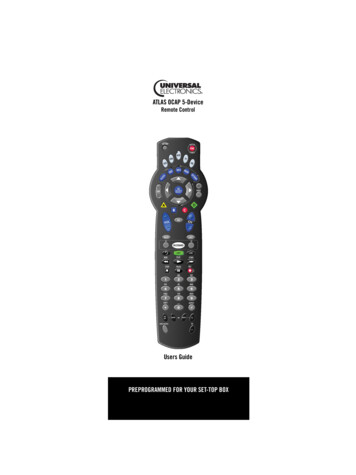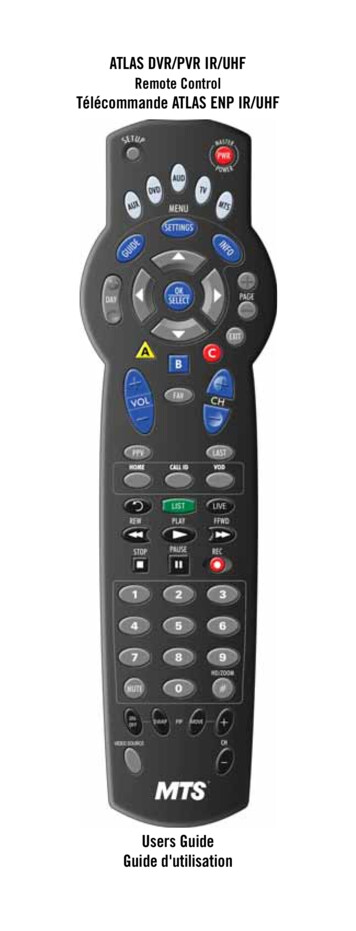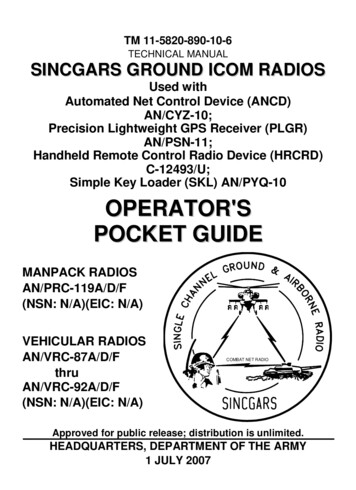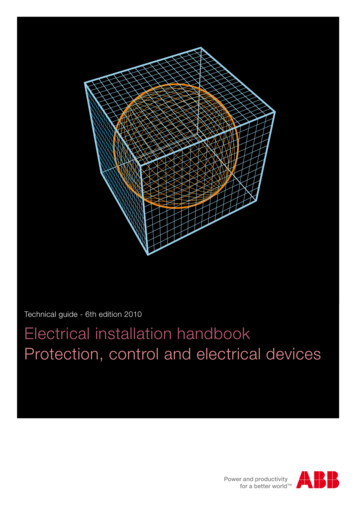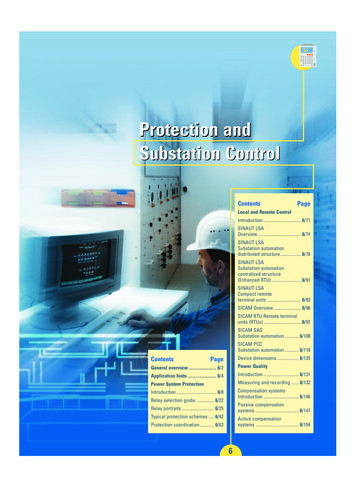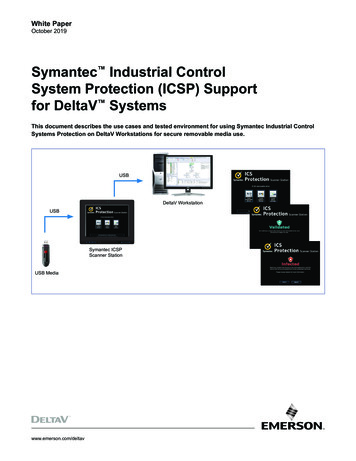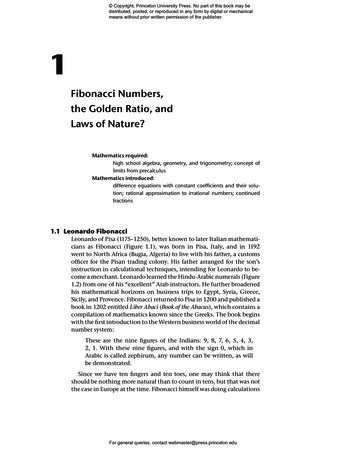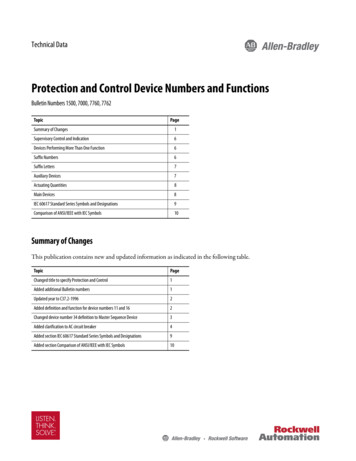
Transcription
Technical DataProtection and Control Device Numbers and FunctionsBulletin Numbers 1500, 7000, 7760, 7762TopicPageSummary of Changes1Supervisory Control and Indication6Devices Performing More Than One Function6Suffix Numbers6Suffix Letters7Auxiliary Devices7Actuating Quantities8Main Devices8IEC 60617 Standard Series Symbols and Designations9Comparison of ANSI/IEEE with IEC Symbols10Summary of ChangesThis publication contains new and updated information as indicated in the following table.TopicPageChanged title to specify Protection and Control1Added additional Bulletin numbers1Updated year to C37.2-19962Added definition and function for device numbers 11 and 162Changed device number 34 definition to Master Sequence Device3Added clarification to AC circuit breaker4Added section IEC 60617 Standard Series Symbols and Designations9Added section Comparison of ANSI/IEEE with IEC Symbols10
Protection and Control Device Numbers and FunctionsDescriptionThe protection and control devices in electrical equipment can be referred to by numbers, with appropriate suffix letterswhen necessary, according to the functions they perform.These numbers are based on a system that is adopted by a standard for automatic switchgear by Institute of Electrical andElectronics Engineers (IEEE), and incorporated in American Standard C37.2-1996. This system is used with diagramsthat are found in instruction books and in specifications. The International Electrotechnical Commission (IEC)standards 617 and 60617 also provide different symbols and terminology for most of the device numbers that are definedby C37.2. The second portion of this document provides a brief overview of a few of the more common IEC symbolsused.Device Number DefinitionFunction1Master ElementThe initiating device, such as a control switch, that directly or indirectly places equipment in or out of operation.2Time-Delay starting or closing relayA device that functions to give a desired amount of time delay before or after any point of operation in a switchingsequence or protective relay system, except as provided by device functions 48, 62, and 79.3Checking or interlocking relayA relay that operates in response to the position of a number of other devices (or to a number of predeterminedconditions) in equipment to allow an operating sequence to proceed, to stop, or to provide a check of the position ofthese devices or conditions for any purpose.4Master contactorA device, which is controlled by device function 1 or the equivalent, and the required permissive and protective deviceswhich serve to make and break the necessary control circuits to place equipment into operation under the desiredconditions and to take it out of operation under abnormal conditions.5Stopping deviceA control device shuts down equipment and hold it out of operation. (This device may be manually or electricallyactuated, but excludes the function of electrical lockout [see device function 86] on abnormal conditions.)6Starting circuit breakerA device whose principal function is to connect a machine to its source of starting voltage.7Rate-of-rise relayA relay that functions on an excessive rate-of-rise of current.8Control power disconnecting deviceA disconnecting device, such as a knife switch, circuit breaker, or pull-out fuse block that is used for connecting anddisconnecting the source of control power to and from the control bus or equipment.Control power is considered to include auxiliary power that supplies such apparatus as small motors and heaters.9Reversing deviceA device that is used for reversing a machine field or for performing any other reversing functions.10Unit sequence switchA switch that is used to change the sequence in which units may be placed in and out of service in multiple-unitequipment.11Multi-function deviceA single, microprocessor-based product which has the capabilities to support three or more protection and controlelements.12Overspeed deviceUsually, a direct-connected speed switch that functions on machine overspeed.13Synchronous-speed deviceA device such as a centrifugal-speed switch, a slip-frequency relay, a voltage relay, an undercurrent relay, or any othertype of device that operates at approximately the synchronous speed of a machine14Underspeed deviceA device that functions when the speed of a machine falls below a predetermined value.15device that functions to match and hold the speed or the frequency of a machine or of a system equal to, orSpeed or frequency matching device Aapproximatelyequal to, that of another machine, source, or system.16Data Communications deviceUsed to label Communication Networking Devices. This element also uses a unique set of suffixes that are applicableonly to Device 16. The first suffix letter is to be either S for serial devices or E for Ethernet devices.The subsequent suffix letters are used to more completely describe the device – with multiple suffix letters allowed: C – Security processing function (VPN, encryption, etc.) F – Firewall or message filter function M – Network managed function (e.g., configured via SNMP) R – Router S – Switch (Examples: port switch on a dial up connection is 16SS, an Ethernet switch is 16ES) T – Telephone component (Example: auto answer modem)A combination example is ‘16ERFCM’ - an Ethernet router with firewall and VPN capability, which can be remotelymanaged via the connected network.2Rockwell Automation Publication 1500-TD210F-EN-E - June 2018
Protection and Control Device Numbers and FunctionsDevice Number DefinitionFunction17Shunting or discharge switchA switch that serves to open or close a shunting circuit around any piece of apparatus (except a resistor), such as amachine field, a machine armature, a capacitor, or a reactor.This excludes devices that perform such shunting operations as may be necessary in the process of starting a machineby devices 6 or 42 (or their equivalent), and also excludes device function 73 that serves for the switching of resistors.18Accelerating or decelerating deviceA device that is used to close or cause the closing of circuits that are used to increase or decrease the speed of amachine.19Starting-to-running transitioncontactorA device that operates to initiate or cause the automatic transfer of a machine from the starting to the running powerconnection.20Electrically operated valveAn electrically operated, controlled, or monitored valve in a fluid, air, gas, or vacuum line. The function of the valvemay be more completely indicated by the use of the suffixes as discussed in 3.2.21Distance relayA relay that functions when the circuit admittance, impedance, or reactance increases or decreases beyond apredetermined value.22Equalizer circuit breakerA breaker that serves to control or to make and break the equalizer or the current-balancing connections for a machinefield, or for regulating equipment, in a multiple-unit installation.23Temperature control deviceA device that functions to raise or lower the temperature of a machine or other apparatus, or of any medium, when itstemperature falls below, or rises above, a predetermined value.An example is a thermostat that switches on a space heater in a switchgear assembly when the temperature falls to adesired value. This should be distinguished from a device that is used to provide automatic temperature regulationbetween close limits, and would be designated as device function 90T.24Volts per hertz relayA relay that functions when the ratio of voltage to frequency exceeds a preset value. The relay may have aninstantaneous or a time characteristic.25Synchronizing or synchronismcheck deviceA device that operates when two AC circuits are within the desired limits of frequency, phase angle and voltage topermit or to cause the paralleling of these two circuits.26Apparatus thermal deviceA device that functions when the temperature of the protected apparatus (other than the load-carrying windings ofmachines and transformers as covered by device function number 49) or of a liquid or other medium exceeds apredetermined value; or when the temperature of the protected apparatus or of any medium decreases below apredetermined value.27Undervoltage relayA relay that operates when its input voltage is less than a predetermined value.28Flame detectorA device that monitors the presence of the pilot or main flame as in such apparatus as a gas turbine or a steam boiler.29Isolating switch or contactorA device that is used expressly for disconnecting one circuit from another for the purposes of emergency operation,maintenance, or test.30Annunciator relayA non-automatically reset device that gives a number of separate visual indications upon the functioning of protectivedevices, and which may also be arranged to perform a lockout function.31Separate excitation deviceA device that connects a circuit, such as the shunt field of a synchronous converter, to a source of separate excitationduring the starting sequence.32Directional power relayA relay that operates on a predetermined value of power flow in a given direction or upon reverse power flow, such asthat resulting from the motoring of a generator upon loss of its prime mover.33Position switchA switch that makes or breaks contact when the main device or piece of apparatus, which has no device functionnumber, reaches a given position.34Master Sequence deviceA device such as a motor-operated multi-contact switch, or the equivalent, or a programming device, such as acomputer, that establishes or determines the operating sequence of the major devices in equipment during startingand stopping, or during other sequential switching operations.35Brush-operating or slip-ring shortcircuiting deviceA device for raising, lowering, or shifting the brushes of a machine, short-circuiting its slip rings, or engaging ordisengaging the contacts of a mechanical rectifier.36Polarity or polarizing voltage deviceA device that operates, or permits the operation of, another device on a predetermined polarity only, or verifies thepresence of a polarizing voltage in equipment.37Undercurrent or underpower relayA relay that functions when the current or power flow decreases below a predetermined value.38Bearing protective deviceA device that functions on excessive bearing temperature or on other abnormal mechanical conditions that areassociated with the bearing, such as undue wear, which may eventually result in excessive bearing temperature orfailure.39Mechanical condition monitorA device that functions upon the occurrence of an abnormal mechanical condition (except that associated withbearings as covered under device function 38), such as excessive vibration, eccentricity, expansion, shock, tilting, orseal failure.Rockwell Automation Publication 1500-TD210F-EN-E - June 20183
Protection and Control Device Numbers and Functions4Device Number DefinitionFunction40Field relayA relay that functions on a given or abnormally low value or failure of machine field current, or on an excessive value ofthe reactive component of armature current in an AC machine indicating abnormally low field excitation.41Field circuit breakerA device that functions to apply or remove the field excitation of a machine.42Running circuit breakerA device whose principal function is to connect a machine to its source of running or operating voltage. This functionmay also be used for a device, such as a contactor, that is used in series with a circuit breaker or other fault-protectingmeans, primarily for frequent opening and closing of the circuit.43Manual transfer or selector deviceA manually operated device that transfers the control circuits to modify the plan of operation of the switchingequipment or of some of the devices.44Unit sequence starting relayA relay that functions to start the next available unit in multiple-unit equipment upon the failure or non-availability ofthe normally preceding unit.45Atmospheric condition monitorA device that functions upon the occurrence of an abnormal atmospheric condition, such as damaging fumes,explosive mixtures, smoke, or fire.46Reverse-phase or phase-balancecurrent relayA relay that functions when the polyphase currents are of reverse-phase sequence, or when the polyphase currents areunbalanced or contain negative phase-sequence components above a given amount.47Phase-sequence or phase-balancevoltage relayA relay that functions upon a predetermined value of polyphase voltage in the desired phase sequence, when thepolyphase voltages are unbalanced, or when the negative phase-sequence voltage exceeds a given amount48Incomplete sequence relayA relay that generally returns the equipment to the normal, or off, position and locks it out if the normal starting,operating or stopping sequence is not properly completed within a predetermined time.49Machine or transformer thermalrelayA relay that functions when the temperature of a machine armature winding or other load-carrying winding orelement of a machine or power transformer exceeds a predetermined value.50Instantaneous overcurrent relayA relay that functions instantaneously on an excessive value of current.51AC time overcurrent relayA relay that functions when the AC input current exceeds a predetermined value, and in which the input current andoperating time are inversely related through a substantial portion of the performance range.52AC circuit breakerA device that is used to close and interrupt an AC power circuit under normal conditions or to interrupt this circuitunder fault or emergency conditions. The use of a contact symbol with an adjacent ‘M’ should be used to identifymedium voltage contactors, rather than the device number 52. Medium voltage contactors should not be definedusing this device number.53Exciter or DC generator relayA relay that forces the DC machine field excitation to build up during startup, or that functions when the machinevoltage has built up to a given value.54Turning gear engaging deviceAn electrically operated, controlled, or monitored
Comparison of ANSI/IEEE with IEC Symbols 10 Topic Page Changed title to specify Protection and Control 1 Added additional Bulletin numbers 1 Updated year to C37.2-1996 2 Added definition and function for device numbers 11 and 16 2 Changed device number 34 definiti on to Master Sequence Device 3 Added clarification to AC circuit breaker 4 Added section IEC 60617 Standard Series



